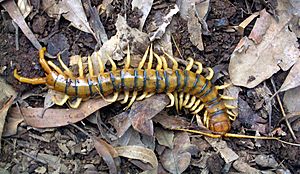Giant centipede facts for kids
Quick facts for kids Giant centipede |
|
|---|---|
 |
|
| Scientific classification | |
| Kingdom: | |
| Phylum: | |
| Subphylum: | |
| Class: | |
| Order: | |
| Family: |
Scolopendridae
|
| Genus: |
Ethmostigmus
|
| Species: |
E. rubripes
|
| Binomial name | |
| Ethmostigmus rubripes (Brandt, 1840)
|
|
The Ethmostigmus rubripes, also known as the giant centipede, is the biggest centipede found in Australia. Its size can change depending on where it lives.
These centipedes are usually between 7.5 to over 16 centimeters (about 3 to 6.5 inches) long. Some can even grow longer than 20 centimeters (almost 8 inches)! Their colors and patterns vary a lot. You might see them in shades of yellow and orange.
Centipedes from dry places are often pale yellow. Those from rainforests can be dark green or blue. Their body shape also changes with their home. Centipedes from dry areas are usually strong and stocky with short legs. Those from tropical places have longer legs and a lighter build. The Ethmostigmus rubripes also has three different types, called subspecies, with many differences within each type.
Contents
Where Giant Centipedes Live
Giant centipedes live in many different places. You can find them in both dry and wet areas. This includes tropical rainforests and even deserts.
They usually hide in sheltered spots. These can be under logs, in leaf litter, under tree bark, or beneath rocks. This centipede is a land animal and lives alone. It is also active at night, hunting for food.
These centipedes are common in Australia. They show the most variety there. You can also find them in the Solomon Islands, New Guinea, Indonesia, and parts of Southeast Asia.
What Giant Centipedes Eat
E. rubripes is a very hungry eater. It preys on many different creatures. Insects, snails, and worms are common meals for most of them.
They also eat spiders and other arachnids. Bigger centipedes can even catch small vertebrates. These are animals with backbones, like small lizards or frogs. The centipede uses its strength and powerful venom to overpower its prey. They have also been seen eating dead animals found on roads.
Reproduction and Life Cycle
Female giant centipedes lay their eggs in groups. A group usually has about thirty eggs. Sometimes there are fewer than ten, or more than forty.
The mother centipede stays with her eggs. She guards them until the babies hatch. She also protects the young centipedes until they have shed their skin twice. The eggs usually take over a month to hatch. After hatching, the baby centipedes stay with their mother for a few weeks.
Giant Centipede Venom
The giant centipede has special legs called forcipules. These are attached to its first body segment. They curve around its head. The forcipules can deliver venom into its prey.
The venom is harmful to both mammals and insects. It is not strong enough to quickly kill large animals. For humans, a bite can cause severe pain. This pain might last for several days. Applying icepacks can help to relieve some of the pain. Some people say the pain is "intense." Others report it feels no worse than a wasp sting.


